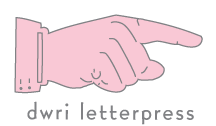The Type
Hot metal typecasting machines were developed in the later part of the 19th and early 20th Centuries to automate the individual typecasting and hand typesetting that had been the standard in commercial printing since Gutenberg began casting handset metal type in 1455 and for two centuries in Korea before that. Although many of our projects are printed using polymer plates created from digital files, we continue to cast type for many posters, business cards, chapbooks, and other projects when it is needed or preferable. We also cast type to the trade for bookbinders to use for foil stamping, ceramic artists working in three-dimensions for debossing onto clay, fellow printers, and perhaps even you!
A current list of our typefaces available for casting can be found below, along with specimen sheets of select Linotype, Ludlow, and Wood type samples, all of which can be downloaded for off-line reference. Individual ludlow slugs can be ordered in our store, but please fill out the form below or contact us with any questions or for a more detailed quote for a specific project.
Typecasting Request Form
Type Sample Books
Wood Type
New type is added frequently, and we have many cases of hand-set foundry type as well. If you have a particular typeface in mind but do not see it here or have questions about a possible typecasting project, please fill out the form below and we will see what we can do!
The Nerdy Details
So, what do we mean by typecasting? Typecasting, or linecasting in our case, involves arranging type matrices (brass “molds” punched from the original dies drawn in the 1900’s to 1960’s) into the words and order you wish to print. They are then lined up to a mold, filled with a molten lead/tin/antinomy alloy, and cast onto a slug to be used as new, never before printed raised type. When the project has been printed and is finished, the type slugs are then melted down and re-cast for the next project.
We cast Ludlow type from 6 to 96pt, on a 6 or 12pt body at 22 1/2 picas. Linotype slugs are cast from 6 to 18pt, automatically set from a keyboard, and therefore much faster than handset Ludlow typecasting. For these reasons, Linotype slugs were used primarily for “body type”, the larger mass of type in book pages, newspaper columns, etc, and Ludlow type was used for “display type”, headlines, posters, etc. Linotype slugs are cast at 30 picas, on a 10, 12, 15, or 18pt body - meaning the thickness of the type slug will be 10 to 18 points - the equivalent of setting the “leading” in digital type layout programs such as Indesign or Illustrator.
For more information on the workings and transformative history of the Linotype machine, see the videos below or watch a recent documentary Linotype: The Film. The last night of hot metal typecasting at the New York Times is documented in the first video, Farewell, eatoin shrdlu, and is truly a portrait of the end of an era. But to see what Dan is up in adapting the machine to our era, you really should be following The Linotype Daily on instagram, or subscribing to his Patreon to receive paper copies!
Please see our Ludlow Type or Linotype Samples for reference.












